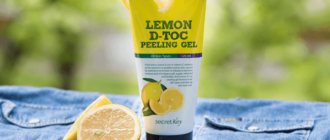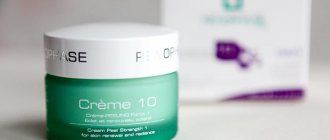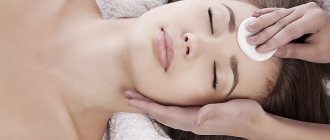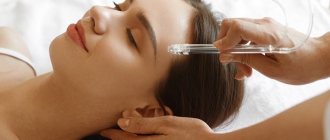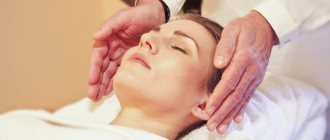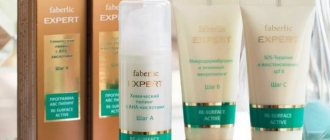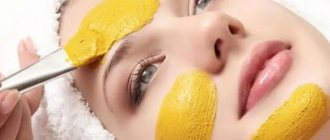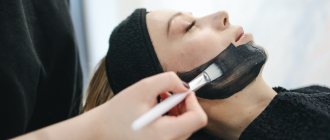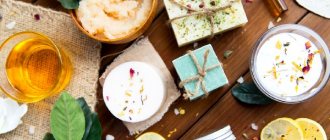Phytic peeling is a procedure for treating the skin with a chemical composition based on acid, which is obtained from the cake (residue after pressing the oil) of rice or wheat seeds. Used to treat acne, eliminate age spots and smooth out facial wrinkles. The composition for the procedure has a soft, gentle effect, so phytin peeling can be used to treat dry and sensitive skin.
Features of the procedure
The procedure is based on the use of phytic acid, which is obtained from wheat cake or rice bran for cosmetic preparations.
Initially, this method of skin rejuvenation became widespread in Hollywood - with its help, actors got rid of the unpleasant consequences of prolonged application of makeup on the face. Therefore, the second name of the procedure is Hollywood peeling.
Phytin peeling is a superficial type of treatment. Phytin molecules are quite large in size, due to which the substance penetrates only to the upper surface of the stratum corneum.
However, this property of the acid manifests itself only if its exposure time is no more than 15 minutes. Longer exposure may lead to undesirable effects.
Applying a solution with phytin to the skin leads to gentle exfoliation. As a result, dead epidermal cells are removed, skin respiration improves, and metabolic reactions are activated.
This effect not only rejuvenates the face, but also helps to cope with acne marks, rosacea, reduces oily shine, and prevents the formation of pimples.
Peeling with phytin is used when it is necessary to cope with stretch marks on the body, reduce the severity of scars, and remove fine wrinkles.
Phytin peeling also has a brightening effect on the skin. Under the influence of acid, the secretion of enzymes that enhance melamine synthesis slows down - pigment spots become less noticeable.
Hollywood peeling can be done at any time of the year. Recovery after the procedure occurs quickly. There are no painful sensations during the session, and there are few contraindications to this method of facial rejuvenation.
What's happened
Phytic peeling is a type of cosmetic procedure, the method of which involves exposing the layers of the dermis to chemicals, in particular phytic acid. This manipulation allows you to get rid of numerous visible defects.
Phytin peeling is one of the most gentle skin care procedures.
The main active ingredient is acid, which is obtained during the processing of wheat or rice.
Suitable for both treating teenage acne and for refreshing and rejuvenating the face at an older age.
The technique is gentle due to the large size of the molecules of the substance used, which are not able to penetrate deep into the skin. All action is carried out only on a superficial level.
Phytic acid helps reduce the production of melanin, has lightening properties, activates the natural production of collagen, and gently removes various impurities from the surface of the skin.
Phytin peeling copes well with postpartum stretch marks.
After a course of treatment, a visible result is noted in the form of smoothing and blanching of stretch marks. The skin tone at the site of exposure also increases.
Dermatovenerologist, cosmetologist
Zhikhoreva Inna Viktorovna
6 years experience
Tartaric acid is also added to the composition used for the procedure. Sometimes it can be combined with an amber or glycolic solution. When choosing these components, it is necessary to take into account the sensitivity of the patient's skin, as well as the result that he wants to obtain.
Thus, tartaric acid allows you to get rid of age spots, and succinic acid provides the epidermis with the necessary hydration.
Properties of phytic acid and its effect on the skin
In cosmetology, solutions containing from 20 to 50% phytic acid are mainly used. The remaining volume of the drug is filled with other types of acids or other substances that have a positive effect on the epidermis.
However, active exfoliation of the skin, improvement of its structure and functions during peeling occurs precisely due to phytin.
Its main properties, which are valued specifically in cosmetology, are:
- Antioxidant. The acid prevents early cell aging, protects the dermis from free radicals, adsorbs and removes toxins.
- Vascular strengthening. Under the influence of phytin, the walls of blood vessels become stronger and more elastic, which makes it possible to remove visible vascular mesh from the face.
- Whitening. The level of melanin drops gradually, which allows you to cope with even the most pronounced and long-standing hyperpigmentation spots in 6-7 sessions.
- Moisturizing and sebum regulating. After peeling, sebum (sebum) production improves in those with dry skin, while in those with oily skin, on the contrary, sebum production decreases.
- Lifting. Increases the elasticity and firmness of the skin, enhances the production of its own results. The most obvious results of tightening are observed in people over 40 years old, that is, phytin copes well with age-related sagging of the skin, making the oval of the face clearer.
Phytic acid works in several directions at once, which allows not only to cope with unsatisfactory defects, but also has a positive effect on the complexion, evens out its relief, and eliminates signs of photoaging.
Advantages and disadvantages
Phytin peeling is becoming more popular year after year, and the main reason for this is its simplicity, painlessness and versatility.
In addition to this procedure:
- Doesn't require too much preparation.
- Lightens even clearly visible pigmented areas and, most importantly, prevents their reappearance.
- Has an anti-inflammatory effect, relieves the effects of acne.
- Activate the natural processes of regeneration and cell renewal, enhances the production of elastin and collagen.
- It is not contraindicated in conditions of high solar radiation activity, that is, it can be done in the summer.
- Suitable for cleansing faces with overly sensitive skin and signs of rosacea.
- Can be performed at any age.
- Compatible with a number of other cosmetic rejuvenation techniques.
- It does not require strict restrictions during the rehabilitation period, and recovery is much faster compared to other types of chemical peels.
Among the disadvantages, patients note a noticeable tingling of the skin after applying the solution.
You also need to understand that with the help of phytin peeling it will not be possible to remove rough scars or severe acne marks; to find out how best to do this, follow the link above.
This procedure will only help make them less noticeable.
You need to know that large-scale studies of phytic acid have not yet been conducted. Its safety at the time of application and positive effects on the skin have been proven, but there is no data on the long-term consequences of such peeling.
Execution steps
To get maximum results after a phytic acid peel, you must follow a specially designed protocol.
First, the surface of the skin is cleaned of decorative cosmetics, dust, sebum and other contaminants. For this purpose, special mild cleansers are used.
After completing all the preparatory steps, proceed directly to applying the acid composition. Apply it in an even layer using a brush. The holding time is 10-12 minutes until a uniform crust appears.
It is worth noting that the period of exposure to acid can be from 5 to 12 minutes. Everything here will depend on the condition of the skin and the desired effect. Under no circumstances should this period be extended, as the likelihood of getting a burn increases.
Peeling in spring and summer
Facial peeling belongs to the category of aggressive procedures associated with some trauma to the epidermis.
After the required time has elapsed, the remaining product is washed off with water. The surface is wiped with a soothing tonic and moisturized.
Depending on the characteristics of the skin, a nourishing mask with active ingredients can be used if necessary. After its removal, the skin is re-treated with tonic.
On average, one session can take about forty minutes.
Contraindications
Phytin peeling cannot be performed if:
- Hypersensitivity, both to phytin itself and to other components included in the composition of the selected product.
- Pregnancy and during lactation. The toxic effects of phytin on the developing fetus have not been proven or disproven, so it is better not to risk the child’s health.
- Herpes, molluscum contagiosum, eczema, psoriasis. Acid can intensify the manifestations of dermatoses or contribute to the spread of infection.
- Violation of the integrity of the epidermis. Acid getting into wounds and scratches increases their inflammation, which can ultimately result in the formation of rough scars.
- Malignant neoplasms. Peeling can cause tumors to grow.
- Diabetes mellitus, severe diseases of the kidneys, liver, heart.
The cosmetologist should be warned about all chronic pathologies at the initial consultation. You should not hide them from the doctor, since ignoring contraindications leads to undesirable consequences and the appearance of defects on the face that will be difficult to cope with.
Preparation
Before the procedure, you should definitely get advice from a cosmetologist who will select care products that will contain a small concentration of fruit acid. This could be a tonic or lotion, which you need to start wiping your face about a week before the procedure. Such actions are necessary in order to prepare the epidermis for harsher effects of acid preparations.
It is important to first do a test to identify an allergic reaction to the components used. To do this, apply a small amount of the composition to the wrist or elbow area and leave for 20-25 minutes. If after this time a burning sensation, redness or swelling appears, it is better to avoid peeling.
Why can our articles be trusted?
We make health information clear, accessible and relevant.
- All articles are checked by practicing doctors.
- We take scientific literature and the latest research as a basis.
- We publish detailed articles that answer all questions.
If the patient is predisposed to relapses of herpetic disease, then he is prescribed medication. Typically, this may be Acyclovir or other antiherpetic medications.
In addition, preparatory measures include refusing to visit the sauna, bathhouse, swimming pool and solarium. Do not expose your skin to direct sunlight.
Phytin should not be applied to the surface of the epidermis with open lesions. Therefore, if there are cuts, scratches and other wounds on the face, they must first be eliminated and wait for complete healing.
Types of phytin peeling products by composition
In exfoliating cosmetic preparations, phytic acid is the active substance.
But at the same time, it is also combined with other components, which allows you to choose a remedy depending on the main problem:
- Glycolic and tartaric acid reduce the signs of rosacea and prevent the reappearance of capillary mesh on the face.
- Lactic and mandelic acids have a pronounced rejuvenating effect.
- The maximum whitening effect is achieved by preparations in which phytic acid is combined with glycolic, retinoic, azelaic or resorcinol.
- Vitamins E and C in the composition enhance the regenerative abilities of the skin and enhance its protection.
The concentration of phytic acid can be from the very minimum to 60-70%. But such compositions can also be used at home, strictly adhering to all the steps of the procedure indicated in the instructions.
How much does a procedure in a salon cost?
In its pure form, phytic acid costs little, but special formulations containing it are much more expensive. This is due to the fact that only a small number of pharmaceutical companies produce drugs with phytin.
The cost of one procedure ranges from 2 to 5 thousand rubles . A relatively low price is offered by those cosmetologists who know how to prepare compositions for chemical peels on their own.
The choice of a salon and a specialist must be taken very seriously, since we are talking about the health and beauty of the skin. In this case, you should pay attention to the following points:
- the authority of the salon or clinic;
- specialist education;
- availability of certificates confirming the qualifications of a cosmetologist;
- customer reviews;
- experience in this field.
The low cost of the procedure (from 500 to 1000 rubles) indicates that the cosmetologist either offers a low-quality product or does not have sufficient qualifications.
Preparing for peeling
Before phytin peeling, skin preparation is required. It is carried out for 7-10 days, and for severe pigmentation - from 2 to 3 weeks.
Pre-peel preparation includes applying glycolic acid gels to the face daily. At the same time, you can use 15% mandelic acid.
The use of these products loosens the epidermis, which facilitates the penetration of phytic acid deep into the dermis and, accordingly, has a positive effect on the results of peeling.
Peeling brands and approximate prices
The cost of one peeling procedure varies from 40 to 60 dollars, the estimated cost of one course is 200-400 dollars. To carry it out, the following brands of cosmetics are used:
- MedicControlPeel (Russia);
- Skin Tech (Spain);
- Beauty SPA (Italy);
- Skin Medica (USA);
- Phytin peeling Renew (Israel).
The cost of pre-peel preparation is $30-40.
Peeling with phytic acid helps to quickly and painlessly cleanse the skin of impurities, smooth out facial wrinkles and remove age spots, and high-quality preparation for its implementation and highly qualified specialists guarantee a pronounced and long-lasting result.
Stages of the procedure
Phytin peeling takes on average about 40-50 minutes. The number of sessions per course is determined by the severity of the defect and the condition of the skin; there can be from 3 to 9. The interval between procedures is 7 days.
Peeling sequence:
- Remnants of decorative cosmetics are removed from the skin, and the face is cleansed of impurities.
- The skin is degreased. Then you need to wait until it dries completely - the interaction of the components of the exfoliating agent with wet skin can lead to undesirable consequences.
- A solution with phytic acid in an amount of up to 2 ml is distributed evenly over the face and neck. It is best to use a thin brush.
- After 5-15 minutes, the acid is removed from the face with plain water. At the first session, it is recommended to keep the composition for no more than 7 minutes, then this time gradually increases.
- A special tonic gel is applied to the skin, followed by a cream with nourishing ingredients.
- After 5-10 minutes, you need to wash your face again and reapply the tonic composition.
Mild hyperemia and slight swelling persist for 3-5 days. On the 3rd day, peeling of the skin is usually observed. Such reactions indicate the effectiveness of the peeling.
Answers on questions
What peelings are considered products from the Renew series?
The Renew series products include all peelings that have the property of a rejuvenating and skin-restoring effect without the use of injections or surgical techniques. There is also an Israeli one. It produces cosmetics of various directions.
What is the difference between Renophase brand exfoliation products ?
The company's products are divided into programs of purpose: facial skin care corresponding to its type, condition and age category of clients.
Peelings stand out among Renofaz brand products:
- Peeling RenewCollagens (lightens pigmentation of any etiology, combines exfoliation and mesotherapy);
- Peeling Reprogrammation (restructures the skin);
- Renewlift (Renewlift with a tightening effect is intended for women aged + 40).
Does Pleyana offer phytin peels and their cost?
There are no phytin peels in the company’s product catalog for January 2021.
Pleyana offers:
- Gommage (rolling cream without acids) for delicate peeling. Sold in 5 ml sachets at a price of 115 rubles. and 250 ml bottles costing 1334 rubles.
- Glycolic peeling gel 10% in 5 ml sachet and 200 ml dispenser bottle. The first product can be purchased for 140 rubles, and the second costs 1259 rubles.
All prices are current as of January 2021 and are set out in the company’s product catalog. Prices on shopping sites may vary.
Which Onmacabim peeling is suitable for problem skin?
OnMacabim offers PMT Anti Acne Peeling for women with problematic, combination or oily skin. It contains kojic, phytic, and salicylic acid. The average cost of the drug for January 2021 is 2900 rubles.
Let's sum it up
Products with phytic acid perfectly fight teenage acne, signs of photoaging, effectively cleanse and restore the epidermis, and neutralize free radical molecules. Manufacturers offer preparations from the “Professional” and “Home” series, so the procedure can be carried out in the salon and at home. For exfoliation to be beneficial, you need to select products taking into account the condition of your skin and your age category.
Dear readers, please share your reviews about phytin peeling! We will be glad to hear your opinion and are grateful for your feedback.
Complications
Severe adverse reactions after phytin peeling are extremely rare. They are mainly associated with hypersensitivity to the components of the drug or non-compliance with the instructions for use.
In most cases, patients complain of increasing erythema, that is, severe redness of the skin. An allergy is indicated by the appearance of a small rash, severe itching, and increasing burning sensation.
If the rules of asepsis are not observed, pustules may form. Dehydration of the dermis often occurs, that is, severe dehydration, expressed by increased dryness.
Careful care of the renewed epidermis helps to cope with most problems.
For allergic reactions, antihistamines are prescribed. If a herpes infection worsens, you will need to take antiviral drugs.
Peeling results
A noticeable change in the skin for the better can be seen after the first phytin peeling session. The face becomes smoother, its dullness and oily shine disappear, areas of irritation and hyperemia become less visible.
Phytin peeling course:
- Tightens enlarged pores.
- Eliminates pigmentation, wrinkles, acne marks.
- Allows you to make scars less noticeable.
- Increases skin firmness and elasticity.
- Prevents inflammatory reactions.
The result lasts for at least 6 months. Compliance with the rules of facial care, a healthy diet, and taking multivitamin complexes prolong the effect of the peeling. The procedure can be repeated several times, of course, if the cosmetologist does not see any harm to the body in this.
Skin care after the procedure
Skin cleansed of dead cells must be especially carefully cared for for at least one month. In the first few days, you should not touch your face often, especially rub it.
Wash at this time with warm, filtered or boiled water. Also, you cannot use decorative cosmetics for 3-5 days.
The basis of care is creams with moisturizing, photoprotective, nourishing and regenerating components. But first, they use forms that are light in texture, that is, gels, sprays, foams.
Then they switch to creams containing ceramides, panthenol, hyaluronate, phospholipids, shea butter, and shea butter.
Careful selection of cosmetic products and daily use will minimize the risk of scarring, hypopigmentation or hyperpigmentation that may appear after peeling.
Also, before going outside, you should not forget to apply cream with a protective factor of at least SPF 30 to your face.
Recovery period and advantages over other types of peelings
For the first few days after the procedure, the skin should not be touched or scratched. As cleansers, cosmetologists recommend using mild mousses and foams that are easily absorbed and do not cause redness. Decorative cosmetics and creams are allowed to be used after the exfoliation process is completed (after 4-5 days).
For a month after the procedure, you need to protect the skin from the aggressive effects of ultraviolet rays and lubricate it with a moisturizing and nourishing cream. High-quality post-peeling care helps restore the protective function of the epidermis and improves its regeneration process. To quickly recover and reduce the risk of scarring, the skin is moisturized with gels based on hyaluronic acid, panthenol or placenta.
Benefits of superficial chemical peels based on phytic acid:
- all-season – can be carried out at any time of the year;
- versatility – suitable for use in patients with any skin type;
- no risk of developing post-inflammatory hyperpigmentation;
- painlessness;
- minimal risk of complications.
Is it possible to do phytin peeling yourself?
Products for phytin peeling are commercially available. That is, anyone can buy them, but is it worth doing such exfoliation yourself?
The procedure does not require the use of special devices and does not affect the deep layers of the skin, so such peeling is not prohibited from being carried out at home.
However, it is imperative to strictly follow all stages of the session, do not hold phytic acid for more than 15 minutes, and after completing the procedure, apply a cream suitable for your skin type to your face.
It is advisable to make an appointment with a professional cosmetologist for the first session. This way you will be able to fully understand the procedure, and the specialist will give professional recommendations regarding its implementation and subsequent care.
Precautions and advice from cosmetologists
Despite the fact that phytic acid is considered one of the safest peeling agents, it must be used very carefully. In addition to the main contraindications, for which it should not be used under any circumstances, there are temporary prohibitions.
It is not recommended to use phytin peeling for respiratory diseases caused by viral infections and rashes, especially purulent ones.
Experts recommend consulting with a doctor before cleansing with phytic acid to rule out any contraindications.
Phytin peeling is an excellent alternative to other facial skin care procedures that affect the deeper layers of the skin. It can be safely used on thin, sensitive skin prone to pigmentation and rosacea.
What procedures can it be combined with?
Exfoliating the skin with phytin in combination with other aesthetic techniques gives a more pronounced rejuvenating effect and allows you to cope with even the most severe skin defects:
- Combination with biorevitalization and mesotherapy. Biorevitalizant and agents used in mesotherapy increase the metabolic activity of keratinocytes and fibroblasts, and peeling activates the division of these cells.
- Combination with botulinum toxin injection. For noticeably expressed wrinkles, Botox injections are first given, then peeling is carried out. This allows you to rejuvenate the skin even with severe age-related changes.
- Combination with fractional photothermolysis. Phytin peeling is done before photothermolysis in order to prepare the skin for the evaporation of water from the epidermis.
Preparations containing phytic acid
Many manufacturers produce phytin-based cosmetics for peeling.
Usually the bottle contains 10-30 ml, this amount is quite enough for a course of skin cleansing.
- Peeling lotion Renew Renew (Israel). Available in two types. Phytic Acid Peeling solution contains only 50% phytic acid and is best suited to correct age-related changes. In addition to 50% phytic acid, Phytic Tartaric Acid also contains 20% tartaric acid. The combined effect of the two components makes it possible to achieve a pronounced antioxidant effect. Both products are suitable for rejuvenating skin of any type.
- GENTLE SHINE PEEL PLEYANA (Pleyana). This is a multifunctional peeling product consisting of phytic, glycolic, aminocaproic, and succinic acids. Pleyana is most suitable for whitening the skin, reducing inflammation, and normalizing the functioning of the sebaceous glands. It does not have an aggressive effect on the epidermis and at the same time activates natural tissue renewal.
- Lykoberon. Produced in Russia. This is a multi-acid peeling, which also contains natural plant components. Helps cope with acne, effectively cleanses pores, smoothes out fine wrinkles. Suitable for peeling any skin, regardless of its type.
- Onmacabim (Onmacabim). Produced in Israel. In addition to phytin, the complex includes salicylic and glycolic acids. Peeling with Onmakabim evens out the relief, lightens pigmented areas, activates the secretion of collagen fibers, and reduces the severity of acne.
- Glycolicpeel Whitening. Produced by the Russian company MedicControlPeel. The product is enriched with kojic acid, which effectively reduces the secretion of melanin. Glycolicpeel Whitening peeling does not require the application of sunscreen, even if the procedure is carried out in the summer.
- COMPLEX PEEL SOLUTION. It copes well with removing fresh and old scars, is suitable for treating acne, and strengthens sagging aging skin.
Phytic acid in Mene Moy cosmetics
Phytic acid is obtained in laboratory conditions from rice bran or wheat cake. Under industrial conditions, it is extracted by processing parts of plants that directly contain acid.
The consistency is characterized by viscosity, and the appearance is characterized by translucency with a touch of yellowness. The color of the liquid changes depending on the conditions: in a warm and bright place it becomes dark. Without any impurities, the acid is a tasteless and odorless powder. The acid is completely soluble in water and 95% ethanol, but not in an oily environment.
The source of phytic acid is many cereals, legumes and oil plants. It is also found in animal tissues. The widely used component is used in cosmetology and medicine. For cosmetic purposes it is used in dissolved form: usually the concentration is 50%. Phytic acid is used for the synthesis of drugs for the treatment of liver and neurological diseases.
Properties
The most powerful antioxidant of natural origin prevents the appearance of signs of aging. Due to its properties, the component stops the oxidative degradation of lipids and prevents the formation of hydroxyl radicals. Phytic acid can also inhibit xanthine oxidation. The second property is whitening. Deactivation of tyrosinase, an enzyme whose excess is characterized by hyperpigmentation, by phytic acid occurs differently than in the classic version. Professional dermatological products often enhance the effect of acid due to the plant ericolin, which also blocks tyrosinase. Phytic acid is safe and can replace vitamin Q.
Phytic acid is a chelator that forms complex compounds. In terms of its capabilities, it is superior to tetrabasic carboxylic acid and has advantages in relation to complexone-III. In a number of countries, complexone-III is banned due to the fact that it is synthesized by combining highly toxic substances that are extremely hazardous to health. Its safe alternative is phytic acid, which is actively used in various fields, for example, the food industry and the cosmetics industry. Phytic acid has specific effects, and therefore its use does not cause concern: the removal of bound metal complexes from the body occurs bypassing the kidneys, through the gastrointestinal tract.
Application in cosmetology
As for the use of phytic acid in the field of cosmetology, the story begins in the USA, where peeling appeared, which was later called “Hollywood”. Unlike analogues, the effectiveness is colossal, and the period of skin rehabilitation after the procedure takes a minimum of time. Phytic acid does not belong to any of the hydroxy acid groups; its properties are unique. The low pH level does not require any changes, the deep layers of the skin are not damaged, and therefore the consequences of use such as redness are minimized. Due to its size, the acid molecule lingers on the surface layer of the skin and collects hydrogen ions around itself without penetrating into the deeper layers. Phytin binds calcium ions, weakening the connections between cells, exfoliation occurs carefully. The peeling procedure with a phytic acid-based product should be strictly limited in time - no more than 10-15 minutes. Exceeding this limit threatens the stage of destruction of the main cells of the body. The use of phytin peels is possible even in cases of rosacea. This can be a product based on the above-mentioned component, or a combination product that combines azelaic, glycolic and other acids.
Sulfate-free shampoos with low acidity and phytic acid are used for therapeutic and preventive purposes. The component does not affect the hair, but the scalp. With the help of such products you can get rid of dandruff and other inflammatory diseases characterized by hair loss. As for the effect, phytin has a beneficial effect on cuticle scales, reproducing the barrier function. Users of styling products, hair dryers and straighteners should pay special attention to the effectiveness of the above-mentioned shampoos.
Asian cosmetics brands use phytic acid not only in care products, but also in the production of toothpaste for both adults and children. The component prevents the formation of tartar, destruction of enamel and eliminates plaque. Dentists generally recommend the paste as a means of disease prevention and oral hygiene, but a small concentration of acid also works well with strong odors of tobacco, garlic and onions.
What effect does phytic acid have?
The range of products that contain phytic acid is large. Products from various cosmetic companies are intended for the skin of the face, body, head and hair. The use of anti-aging products based on the above-mentioned acid refreshes the complexion and significantly evens out its texture due to exfoliation.
Whitening products get rid of various types of pigmentation; they are less effective, but still help in combating the consequences and preventing acne. Cosmetics containing phytin are also recommended for dry facial skin suffering from dehydration and loss of tone. It increases elasticity, moisturizes and restores healthy color. For dermis with a high degree of oiliness and inflammation, products with phytic acid reduce pores and remove oily shine. Scar tissue problems can be solved with the help of peels based on this potent component.
Products with phytic acid
Products for different purposes contain different concentrations of the substance: for deodorizing agents the optimal rate is 0.5%, for peelings - over 1.5%, and for leave-in products - up to 1.5%.
The M&M system line of products includes the following preparations with phytic acid: 1) Lightening Gel - Lightening gel with phytic acid 30 ml 2) Nutri Cream 4% Phytic Acid - Moisturizing cream with phytic acid 50 g 3) Phytic Acid Cream - Cream with phytic acid 50 g
Summary
Article Name
Phytic acid in Mene Moy cosmetics
Description
Phytic acid has whitening and anti-aging properties. Suitable for any skin type, improves color and tone, exfoliates skin cells.
Author
Maria
Publisher Name
mene-moy.ru
Publisher Logo
Patient reviews
The majority of beauty salon clients who have tried the effects of phytin evaluate this peeling as a gentle, gentle exfoliation and respond positively to the procedure.
Peeling is well tolerated without pain or severe discomfort. There is some peeling on days 2-3, but it is usually insignificant.
Phytin peeling restores freshness to the face, helps to cope with pimples and blackheads, and somewhat lightens pigmented spots.
Many are also attracted by the fact that rejuvenation with phytin is possible for sensitive, rash-prone skin. After the session, the face does not feel tight, there is no feeling of dryness or burning.
One of the disadvantages is that the effect of such an influence depends on how accurately the cosmetologist’s recommendations are followed during the recovery period.
Other reviews.
Reviews from cosmetologists
Phytin peeling is also loved by many professional cosmetologists. Unlike deep methods of exfoliation of the epidermis, this procedure practically does not give any side effects, is easily tolerated, and does not require strict restrictions after implementation.
The results are most pronounced when treating skin with acne and dermatomycosis in remission. After a course of peeling, the severity of pigmentation decreases and wrinkles become less noticeable.
However, many qualified cosmetologists warn that no scientific research has been conducted on the effect of phytin on the dermis.
From a medical point of view, phytic acid has anti-cancer properties, which has been proven through research.
But the long-term consequences of such exfoliation are unknown, so before choosing this rejuvenation technique, you need to evaluate all the pros and cons of the procedure.
